A sigle wave
Superposition of waves
© The scientific sentence. 2010
|
Polarization of light
1. Introduction
We classify waves according to their direction of propagation. A transverse wave oscillates within a plane
perpendicular to its direction of propagation; this is the case of waves on ropes or strings or the electric field of
an electromagnetic wave. The oscillations of the longitudinal wave are parallel to its direction of propagation,
this is the case of the sound waves. Water waves have both transverse and longitudinal components.
Waves on ropes or strings, water waves, and sound waves are Mechanical waves. They require a medium in which they can
travel and transport energy, and they can be described by Newton's laws. Electromagnetic waves travel within a medium or
through vacuum. Traveling waves, as light, travel along a direction of propagation, in contrast with Standing waves, as in
a guitar, that are confined to a certain space by boundaries. Waves can travel in two dimensions space, such as water waves that
travel radially forming expanding concentric circles of crests (and troughs), separated by one wavelength, that are called
wavefronts. Sound waves or light waves travel in three dimensions space forming concentric spherical surfaces
as wavefronts within a uniform medium. These kind of waves, coming from a point source and traveling through all the space
(three dimensions) are called spherical waves. At a large distance from the point source, the spherical wavefronts are generally
planar wavefronts. Such waves are called plane waves. The solutions of the Maxwell's equations are plane waves. For
these waves, if the direction of propagation is along "z", and the electric field E of the wave oscillates along "y", then the magnetic
field B will oscillate along "x" (E is c times greater that B), the electric field E oscillates in th the plan "yz". We say that
the transverse electromagnetic radiation oscillating in the plan "yz" is polarized. The plan "yz" the plane of polarization.
In the present chapter, we will set the equation of the polarization for two waves in two dimensions and get the
particular cases of linearly, circularly, and elliptically polarized waves. We will also show how a
light polarizer and analyzer work and set Malus's law. Finally, we will describe some polarization effects such as dichroism,
polarization by reflection and refraction including Brewster's law, and scattering.
2. Equation of polarization of two waves
Let's consider two waves with same amplitude and same frequency, but with different
phases.
x = a cos (ωt - kz + α) (1)
y = a cos (ωt - kz + β) (2)
x/a = cos (ωt - kz) cos α - sin(ωt - kz) sin α (3)
y/a = cos (ωt - kz) cos β - sin(ωt - kz) sin β (4)
Multiplying (3) by sin β and (4) by sin α gives:
x/a sin β = cos (ωt - kz) cos α sin β - sin(ωt - kz) sin α sin β ( 5)
y/a sin α = cos (ωt - kz) cos β sin α - sin(ωt - kz) sin β sin α (6)
subtracting (5) and (6) gives:
(5) - (6) = x/a sin β - y/a sin α = cos (ωt - kz) cos α sin β - cos (ωt - kz) cos β sin α =
cos (ωt - kz) [cos α sin β - cos β sin α] = cos (ωt - kz) sin( β - α) (7)
Multiplying (3) by cos β and (4) by cos α gives:
x/a cos β = cos (ωt - kz) cos α cos β - sin(ωt - kz) sin α cos β (8)
y/a cos α = cos (ωt - kz) cos β cos α - sin(ωt - kz) sin β cos α (9)
subtracting (8) and (9) gives:
(7) - (8) = x/a cos β - y/a cos α = sin (ωt - kz) cos α sin β - sin (ωt - kz) cos β sin α =
sin (ωt - kz) [cos α sin β - cos β sin α] = sin (ωt - kz) sin ( β - α) (10)
The relationships (7) and (10) become:
x/a sin β - y/a sin α = cos (ωt - kz) sin (β - α) (7')
x/a cos β - y/a cos α = sin (ωt - kz) sin (β - α) (10')
Squaring and adding (7') and (10') gives:
(x/a)2 + (y/a)2 - (2xy/a2)[sin β sin α + cos β cos α] = sin2(β - α)
Or:
(x/a)2 + (y/a)2 - (2xy/a2) cos(α - β )= sin2(β - α)
Finally:
x2 + y2 - 2xy cos(α - β) = a2 sin2(α - β)
3. Different cases
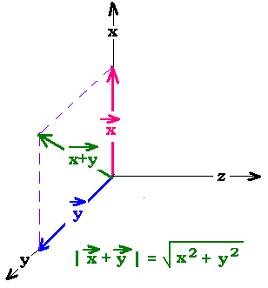
As light is a transverse wave, it can be then polarized in different waves. The polarization of
light is always considered as along the electric field E rather than the magnetic field B
(|E| = c |B|: E is c times greater that B). The plane that contains the field E and the direction
of polarization is the plane of polarization: Here "yz". In this paragraph, the waves "x" and "y"
can represent electric fields of an electromagnetic wave.
3.1. α = β
x2 + y2 - 2xy = 0
From which we have :
(x - y)2 = 0. Or x = y.
That is the resultant of the two waves in phase x and y is
linearly polarized and oscillates along the line y = x.
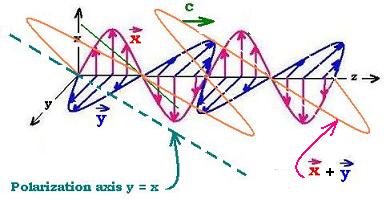
3.2. α = β + π/2
In this case, we have:
x2 + y2 = a2
That is the resultant of the two waves in quadrature phase x and y is
circularly polarized and oscillates in the plane "xy" along the "z" axis with
fixed magnitude. The tip of the vector resultant rotates with constant frequency by tracing out a circle of
radius "a" and moves forward along the "+z" axis (right), which is the direction of the propagation. If "x" rotates
in the clockwise sense, the light is right-circularly polarized; in the counterclockwise sense, the light is
left-circularly polarized.
If the amplitudes of the waves "x" and "y" are different, the resultant will be elliptically polarized.
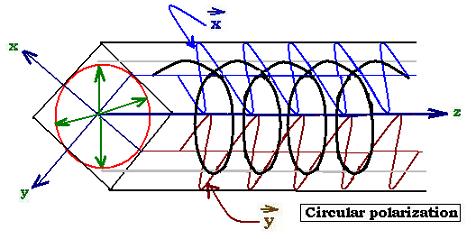
4. How light is polarized
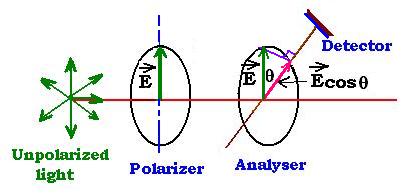
Unpolarized light is emitted in all the directions through space. It can be polarized by passing it
through a polarizer. The well known device to polarize light is the Polaroid film that we use in
sunglasses. The polarizer has a transmission axis by which lets passing light that has its plane of polarization
parallel to it. The perpendicular ones will not be transmitted, and they are blocked by absorption or reflexion.
We add a second polarized called analyzer that transmits only the component of E parallel to its transmission
axis; that is the projection of the vector field E on the analyzer's transmission axis or E cosθ where θ
is the angle between the polarizer's axis and the analyzer's axis. Since the intensity of light is equal to I =
(1/2) c εo E2, we derive then the relationship:
I = Io cos2 θ
That is the Malus's law.
5. Processes to polarize light
5.1. Absorption
A sheet of Polaroid uses the selective absorption called dichroism. The transmission axis of a dichroic
material is due to a certain alignment of molecules or crystalline. Tourmaline crystal has the feature
of dichroic material. Polaroid is made of stretched plastic colored with an ink that contains Iodine.
5.2. Scattering

Skylight, that is light scattered from molecules of the atmosphere is polarized while they receive unpolarized
light from the sun. Of course without those molecules the sky will be seen as it is at night.
The Rayleigh formula
show that the amount of scattering depends mainly on the wavelength of the scattered radiation, the
shorter wavelengths are more scattered than the longer, and this is why the sky appears blue.
The longer the light travels the atmosphere, the more the blue radiation depletes, this is why the
sky is red at sunsets. During the day, we can remark, by observing scattered light coming from the
direction perpendicular to the sun's direction is bright. The electric field of light that propagates
along the z axis has no component along this axis because light is a transverse wave. Its electric field oscillates
then in the polarisation plane "xy". The electric field viewed by the observer from the point "O", remains
in the plane "xy" with no component in the "z" direction. Therefore, light from the scattering
molecules (mostly blue) comes in at right angle to the incident beam of the unpolarized sunlight direction. The
unpolarized transmitted light is mostly red.
5.3. Reflexion and refraction
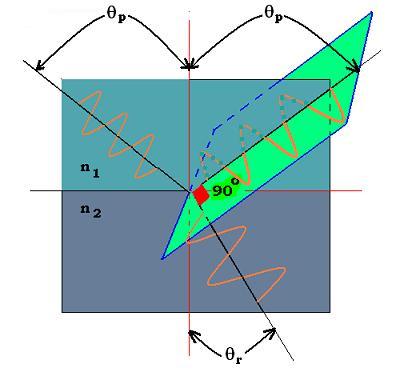
If an unpolarized light beam is incident on a glass surface, the reflected and refracted beam
are partially polarized. At a particular angle, called polarizing angle θp, the
reflected beam is totally polarized perpendicularly to the plane of incidence and then parallel to the
reflecting surface. The refracted beam is parallel to the plane of incidence which contains the incidence
beam, the normal to the surface and the reflected beam.
David Brewster (1781- 1868) discovered experimentally that the reflected and refracted beams, at complete
polarization, are at right angle. From the law of Reflection, we have θincident =
θreflected = θpolarization = θp. According to Snell's law,
we have: n1 sin θp = n2sin θr: where θr =
θrefracted. Therefore: θp + θr = π/2. Thus:
sin θr = sin (π/2 - θp) = cos θp. Hence:
n1 sin θp = n2 cos θp. Then:
n2 /n1 = tg θp.Or:
n21 = n2 /n1 = tg θp
That is Brewster's law.
Example:
For Air-Glass medium θp = arctg(nGlass/nAir) =
arctg(1.5/1.0) = 56o ≈ 1 rad.
Polarizers use also the feature of birefringence (or double refraction) of some materials such
as Calcite (CaCO3) or crystalline quartz (SiO2). The one
of these two refracted rays is called the ordinary ray, the second the extraordinary ray.
They are both polarized in two perpendicular planes of polarization. Notice that for
those medium, Snell's law holds for the ordinary ray only; and holds for both of the rays if the optic axis
of the medium is perpendicular to the plane of incidence.
©: The scientificsentence.net. 2007.
|
|
|